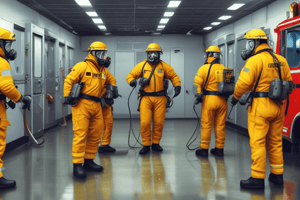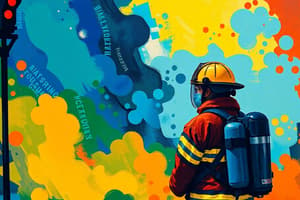Podcast
Questions and Answers
What is the primary purpose of conducting a Post Incident Review (PIR)?
What is the primary purpose of conducting a Post Incident Review (PIR)?
- To analyze actions and improve performance (correct)
- To evaluate the financial cost of the incident
- To generate reports for future incidents
- To assign blame for the incident
Who is responsible for organizing and conducting the PIR?
Who is responsible for organizing and conducting the PIR?
- The highest ranking officer at the scene
- All emergency personnel
- The incident commander from the previous tour
- District Chiefs (correct)
When should a PIR ideally be conducted after an incident?
When should a PIR ideally be conducted after an incident?
- The next day or by the first shift of the next tour (correct)
- Immediately after the incident without delay
- At the end of the week following the incident
- Only when requested by the firefighters
What is the primary mindset participants should maintain during a PIR?
What is the primary mindset participants should maintain during a PIR?
How should constructive criticism be conducted during a PIR?
How should constructive criticism be conducted during a PIR?
What should be done with vehicles associated with the PIR after the incident?
What should be done with vehicles associated with the PIR after the incident?
Which of the following is NOT a guideline for conducting a PIR?
Which of the following is NOT a guideline for conducting a PIR?
What is a potential benefit of conducting a PIR?
What is a potential benefit of conducting a PIR?
What should not be the focus of a PIR?
What should not be the focus of a PIR?
What is an ideal outcome of a PIR?
What is an ideal outcome of a PIR?
What is the purpose of the Post Incident Review (PIR)?
What is the purpose of the Post Incident Review (PIR)?
Which of the following is NOT a consideration during a PIR?
Which of the following is NOT a consideration during a PIR?
What does the PIR help the Incident Commander to achieve?
What does the PIR help the Incident Commander to achieve?
How does the PIR differ from the After Action Review?
How does the PIR differ from the After Action Review?
Which factor is included in the considerations during the PIR?
Which factor is included in the considerations during the PIR?
What role do existing Standard Operating Guidelines (SOGs) play in a PIR?
What role do existing Standard Operating Guidelines (SOGs) play in a PIR?
Which aspect is critical for evaluating the effectiveness of the Incident Management System during a PIR?
Which aspect is critical for evaluating the effectiveness of the Incident Management System during a PIR?
What does the effectiveness of human and physical resources indicate in a PIR?
What does the effectiveness of human and physical resources indicate in a PIR?
Which of the following is listed as a consideration regarding injuries during a PIR?
Which of the following is listed as a consideration regarding injuries during a PIR?
What is a key outcome expected from reviewing hazardous materials during a PIR?
What is a key outcome expected from reviewing hazardous materials during a PIR?
What is the primary objective of a Post Incident Review (PIR)?
What is the primary objective of a Post Incident Review (PIR)?
Which of the following individuals should be prioritized for inclusion in a PIR?
Which of the following individuals should be prioritized for inclusion in a PIR?
What is the recommended approach to conducting a PIR when all participants cannot be gathered in one location?
What is the recommended approach to conducting a PIR when all participants cannot be gathered in one location?
Which of the following is considered an inappropriate approach during a PIR?
Which of the following is considered an inappropriate approach during a PIR?
What is the recommended procedure for including input from the Communication Centre Dispatcher in a PIR?
What is the recommended procedure for including input from the Communication Centre Dispatcher in a PIR?
Which of the following is NOT a point for consideration during a PIR?
Which of the following is NOT a point for consideration during a PIR?
What is the most effective way to reconstruct the sequence of events during a PIR?
What is the most effective way to reconstruct the sequence of events during a PIR?
Why is it essential to have representation from support divisions and outside agencies in a PIR?
Why is it essential to have representation from support divisions and outside agencies in a PIR?
What is the main purpose of conducting an initial size-up during an incident as part of a PIR?
What is the main purpose of conducting an initial size-up during an incident as part of a PIR?
What is the primary role of the Critical Incident Stress team in a PIR?
What is the primary role of the Critical Incident Stress team in a PIR?
Flashcards
Post-Incident Review (PIR)
Post-Incident Review (PIR)
A formal review of an emergency incident conducted after it occurs.
Purpose of a PIR
Purpose of a PIR
The review should focus on improving performance and learning from mistakes, not assigning blame.
Representation in a PIR
Representation in a PIR
Involving participants from various divisions and outside agencies ensures a wide range of perspectives.
Participant Involvement in a PIR
Participant Involvement in a PIR
Signup and view all the flashcards
Fact-based Analysis in a PIR
Fact-based Analysis in a PIR
Signup and view all the flashcards
Chronological Reconstruction in a PIR
Chronological Reconstruction in a PIR
Signup and view all the flashcards
Alarm Reception & Dispatch in a PIR
Alarm Reception & Dispatch in a PIR
Signup and view all the flashcards
Pre-arrival Problems in a PIR
Pre-arrival Problems in a PIR
Signup and view all the flashcards
Initial Radio Report in a PIR
Initial Radio Report in a PIR
Signup and view all the flashcards
Initial Situation Assessment in a PIR
Initial Situation Assessment in a PIR
Signup and view all the flashcards
STANDARD OPERATING GUIDELINE - POST INCIDENT REVIEW
STANDARD OPERATING GUIDELINE - POST INCIDENT REVIEW
Signup and view all the flashcards
Responsibility for PIR participation
Responsibility for PIR participation
Signup and view all the flashcards
District Chief's role in PIR
District Chief's role in PIR
Signup and view all the flashcards
Timing of PIRs
Timing of PIRs
Signup and view all the flashcards
Frequency of PIRs
Frequency of PIRs
Signup and view all the flashcards
Scope of PIRs
Scope of PIRs
Signup and view all the flashcards
PIR participation expectations
PIR participation expectations
Signup and view all the flashcards
Overall goal of PIRs
Overall goal of PIRs
Signup and view all the flashcards
Incident Management System (IMS)
Incident Management System (IMS)
Signup and view all the flashcards
Incident Management System Assessment
Incident Management System Assessment
Signup and view all the flashcards
Communications Effectiveness Assessment
Communications Effectiveness Assessment
Signup and view all the flashcards
Fire Protection Systems and Equipment Assessment
Fire Protection Systems and Equipment Assessment
Signup and view all the flashcards
Fire Cause Analysis
Fire Cause Analysis
Signup and view all the flashcards
Resource Utilization Analysis
Resource Utilization Analysis
Signup and view all the flashcards
SOGs & Policies Effectiveness Assessment
SOGs & Policies Effectiveness Assessment
Signup and view all the flashcards
Safety Procedures Evaluation
Safety Procedures Evaluation
Signup and view all the flashcards
Measures to Improve Future Performance
Measures to Improve Future Performance
Signup and view all the flashcards
Study Notes
Post Incident Review (PIR) Guidelines
-
Purpose: To provide a guideline for conducting post-incident reviews for Toronto Fire Services personnel, learning from experiences and improving on-scene performance.
-
Responsibility: All personnel involved in the incident are responsible for constructive participation. District Chiefs are responsible for organizing, coordinating, and conducting the PIR.
-
Timing: PIRs should occur as soon as possible after the incident, ideally the next day, or the first shift of the next tour. If the incident occurred on the last day of a shift, it can be conducted as the first shift of the next tour.
-
Scope: The purpose is to improve performance by identifying effective strategies and tactics to support significant responses. Learn from previous events, leading to more efficient operations and enhanced future training.
-
Objective: Maintain objectivity during the review. Focus on performance and actions taken, with constructive criticism provided in a positive manner.
-
Participants: Representation from support divisions and outside agencies (e.g., Communication Centre, Fire Prevention Division, Training and Technical Operations Division, Critical Incident Stress team members) should be considered.
-
Discussion: Reviews should focus on verifiable facts and avoid second-guessing or conjecture.
-
Points for Consideration: Event sequence, vehicle placement/use and member actions should be considered. Pre-arrival issues (traffic, weather, etc.), radio reports, initial size-ups, search and rescue procedures, exposures, ventilation and salvage efforts need thorough review.
-
Lessons Learned: The PIR is intended to facilitate learning and improve future incident responses. It does not replace an after-action review (AAR) if one is necessary. The post incident review should help build a stronger team.
Studying That Suits You
Use AI to generate personalized quizzes and flashcards to suit your learning preferences.




